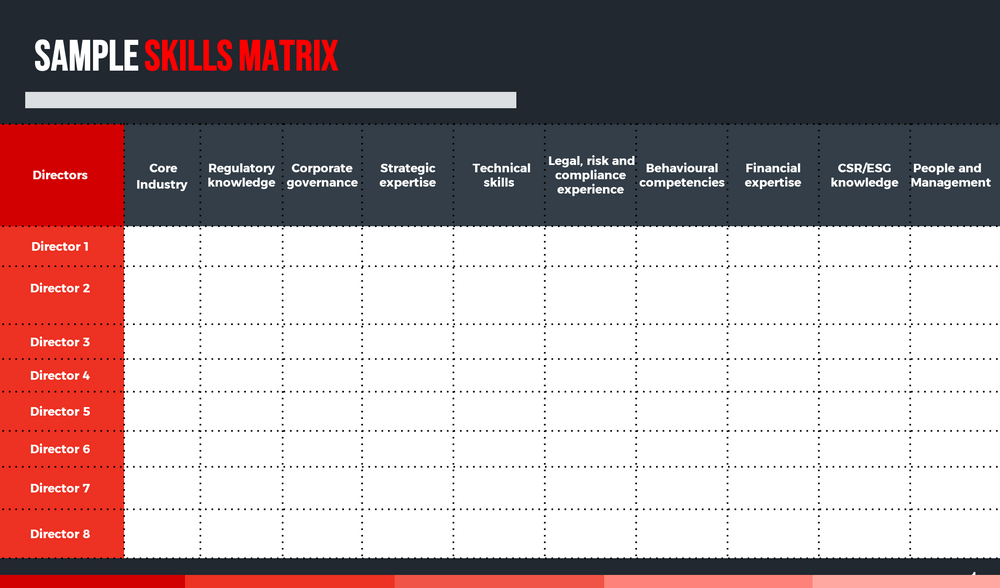Research & Insights

The Board of Directors of a company serves as the representative of the shareholders - they are entrusted with ensuring that the shareholders' interests are protected and upheld, the management is adequately monitored, and the requisite strategic decisions are taken on a timely basis. It is, therefore, critical that the board has the optimal composition, with the ideal amalgamation of talent, skill set, and experience.
For this, the selection of non-executive board members with adequate skills and experience is of the utmost importance. Since there is no such thing as 'one size fits all' in terms of the composition of a company's board, it is necessary to have a company-specific vision of the required skills and experience of prospective board members.
A skill matrix can prove to be a valuable tool for this.
A skill matrix is a framework that details the skills required for a particular role in an organisation. In the context of the board of directors of a company, a skill matrix can serve as a simple and seamless yet efficient tool to:
Although the skill matrix for every organisation's board is distinct, there are some unifying themes found in skill matrices spanning various sectors, such as executive leadership skills, industry expertise and experience, digital and technological expertise and so on.
Irrespective of the form and shape of a skill matrix, its main goal remains unaltered - the identification of the skill gap in a board and its timely addressal.
Under the chairmanship of Mr Uday Kotak, one of the focal points of the Kotak Committee Recommendations of 2017 was to enhance the degree of transparency for Indian companies, resulting in higher corporate governance. To this end, it proposed some key recommendations pertaining to the disclosure norms for listed entities, especially the ones crucial to the skillset of the board of directors.
Not only is the deployment of a skill matrix essential from a compliance perspective (as mandated by the Kotak Committee Recommendations 2017), but it is also an effective roadmap that can enable an organisation to achieve diversity of skills and experience in its board and realise its full potential.
Before the compliance angle altered the tapestry of board assessment and review for companies, the companies in India were divided in their adoption of the skill matrix. A few companies were reluctant and hesitant with the skill matrix implementation, which necessitated the legal mandate.
However, there were several companies that implemented the skill matrix process for board hiring even before the mandate owing to its wide range of benefits.
The application of a skill matrix can make the challenging task of hiring a well-rounded, diverse, and competent board simple and seamless.
Here are some benefits of adopting a skill matrix:
Although the skill matrix approach is an excellent choice for any organisation, there are some pitfalls that the company should be careful about. For instance, the skills matrix approach can make a company myopic in its approach to hiring board members.
However, all these can be expertly managed by ensuring a well-rounded and holistic approach towards creating a unique skill matrix catered to your organisation. Also, the pros of a skill matrix far outweigh its cons. With a measured approach, such a matrix can help an organisation build an adequately diverse, highly skilled, and optimally experienced board.
At Vahura, we apply a diverse skill matrix to enable our clients to have an optimal board of directors. Seldom do the boards of distinct entities require directors with the same skills; keeping this in mind, we endeavour to offer a customised Vahura experience to each of our clients.
A simpler representation of the skill table used at Vahura:

*The categories listed in the skill matrix table above are a few examples of skills which are deemed important at a board level globally. Vahura adopts a more extensive and customized table.
The optimal board composition is contingent upon a myriad of company-specific variables, including the current stage of development of a particular company, its exposure to and requirement of distinct technological solutions, its international expansion plans (if any), and the required degree of access to capital markets.
With a holistic approach that extends far beyond a skill matrix, we aim to understand the unique requirements of a particular board and deliver an adequate solution. We have been thought leaders at the forefront in the adoption of skill matrices long before it became a legal mandate.